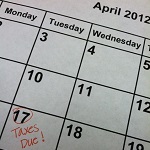 There are options available to taxpayers which are quick and easy solutions if they can’t file their returns or pay their taxes on time…there is no need to panic!
There are options available to taxpayers which are quick and easy solutions if they can’t file their returns or pay their taxes on time…there is no need to panic!
Tax-filing extensions are available to taxpayers who need more time to finish their returns. Remember, this is an extension of time to file; not an extension of time to pay. However, taxpayers who are having trouble paying what they owe usually qualify for payment plans and other relief. Last month, for example, the IRS, as part of its Fresh Start initiative announced penalty relief for unemployed taxpayers and self-employed individuals whose income has dropped.Either way, taxpayers will avoid stiff penalties if they file either a regular income tax return or a request for a tax-filing extension by this year’s April 17 deadline. Taxpayers should file, even if they can’t pay the full amount due. Here are further details on the options available.
More Time to File
People who haven’t finished filling out their return can get an automatic six-month extension. The fastest and easiest way to get the extra time is through the Free File link on IRS.gov. In a matter of minutes, anyone, regardless of income, can use this free service to electronically request an automatic tax-filing extension on Form 4868.
Filing this form gives taxpayers until October 15 to file a return. To get the extension, taxpayers must estimate their tax liability on this form and should also pay any amount due.
By properly filing this form, a taxpayer will avoid the late-filing penalty, normally five percent per month based on the unpaid balance, that applies to returns filed after the deadline. In addition, any payment made with an extension request will reduce or eliminate interest and late-payment penalties that apply to payments made after April 17. The current interest rate is three percent per year, compounded daily, and the late-payment penalty is normally 0.5 percent per month.
We are also available to assist in filing an extension. If you need help in estimating your income and the amount you have due, please contact us to assist with preparation of Form 4868.
Some taxpayers get more time to file without having to ask for it. These include:
- Taxpayers abroad. U.S. citizens and resident aliens who live and work abroad, as well as members of the military on duty outside the U.S., have until June 15 to file and pay. However, interest is still due on any tax payment made after April 17.
- Members of the military and others serving in Iraq, Afghanistan or other combat zone localities. Typically, taxpayers can wait until at least 180 days after they leave the combat zone to file returns and pay any taxes due. For details, see Extensions of Deadlines in Publication 3, Armed Forces Tax Guide.
- People affected by certain tornadoes, severe storms, floods and other recent natural disasters. Currently, parts of Indiana, Kentucky, Tennessee and West Virginia are covered by federal disaster declarations, and affected individuals and businesses in these areas have until May 31 to file and pay.
Easy Ways to E-Pay
Taxpayers with a balance due IRS now have several quick and easy ways to electronically pay what they owe. They include:
- Electronic Federal Tax Payment System (EFTPS). This free service gives taxpayers a safe and convenient way to pay individual and business taxes by phone or online. To enroll or for more information, call 800-316-6541 or visit www.eftps.gov.
- Electronic funds withdrawal. E-file and e-pay in a single step.
- Credit or debit card. Both paper and electronic filers can pay their taxes by phone or online through any of several authorized credit and debit card processors. Though the IRS does not charge a fee for this service, the card processors do. For taxpayers who itemize their deductions, these convenience fees can be claimed on Schedule A Line 23.
Taxpayers who choose to pay by check or money order should make the payment out to the “United States Treasury.” Write “2011 Form 1040,” name, address, daytime phone number and Social Security number on the front of the check or money order. To help insure that the payment is credited promptly, also enclose a Form 1040-V payment voucher.
More Time to Pay
Taxpayers who have finished their returns should file by the regular April 17 deadline, even if they can’t pay the full amount due. In many cases, those struggling with unpaid taxes qualify for one of several relief programs, including those recently expanded under the IRS“Fresh Start” initiative. These include the following:
- Most people can set up a payment agreement with the IRS on line in a matter of minutes. Those who owe $50,000 or less in combined tax, penalties and interest can use the Online Payment Agreement to set up a monthly payment agreement for up to six years. Taxpayers can choose this option even if they have not yet received a bill or notice from the IRS. Alternatively, taxpayers can request a payment agreement by filing Form 9465-FS. This form can be downloaded from IRS.gov and mailed along with a tax return, bill or notice.
- Most unemployed filers and self-employed individuals whose business income dropped substantially can apply for a six-month extension of time to pay. Eligible taxpayers will not be charged a late-payment penalty if they pay any tax, penalty and interest due by Oct. 15, 2012. Taxpayers qualify if they were unemployed for any 30-day period between Jan. 1, 2011 and April 17, 2012. Self-employed people qualify if their business income declined 25 percent or more in 2011, due to the economy. Income limits and other special rules apply. Apply using Form 1127-A.
- Some struggling taxpayers may qualify for an offer-in-compromise. This is an agreement between a taxpayer and the IRS that settles the taxpayer’s tax liabilities for less than the full amount owed. Generally, an offer will not be accepted if the IRS believes the liability can be paid in full as a lump sum or through a payment agreement. The IRS looks at the taxpayer’s income and assets to make a determination regarding the taxpayer’s ability to pay.
Details on all filing and payment options are on IRS.gov.




